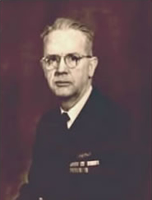Laurance Safford
Laurance F. Safford (born October 22, 1893 in Somerville , Middlesex County , Massachusetts , † May 15, 1973 in Bethesda , Montgomery County , Maryland ) was an American cryptographer who is considered the founder of US Navy cryptography.
Live and act
Safford graduated from Annapolis Naval Academy in 1916 as the 15th of his year. He initially served on a minesweeper off China, but thanks to his talent for mathematics, he was transferred to the research department of the cryptographic department of the US Navy (Code and Signal Section, Office of Naval Communication) in 1924 , where he initially left the Japanese consulate in Washington should examine stolen Japanese naval code books. He expanded the department, which he led until shortly after the Second World War , and capable employees such as Agnes Meyer Driscoll , Joseph Rochefort (who was responsible for deciphering Japanese naval codes in Hawaii from 1941, Hypo station in Pearl Harbor) and Joseph N. Wenger recruited. His work as a cryptographer was interrupted in the years 1926 to 1929 and 1932 to 1936, when he served on ships. In 1953 he retired. He had the rank of captain.
Thanks to Safford, the US Navy had a system of listening stations as early as the 1930s. His cryptographic service itself was located in Washington, Hawaii and Manila. He also developed encryption machines ( SIGABA ) with the US Army cryptographer Frank Rowlett . For the decryption of Japanese codes, he also developed and used early computer aids (punch card machines, taken over by IBM ). He worked on Japanese diplomatic codes with the US Army cryptographers. When he saw signs of war preparations in diplomatic communications shortly before Pearl Harbor , he tried to warn, but this was blocked by his superior (Admiral Leigh H. Noyes). One of the successes of his employees (Rochefort in Hawaii) was the partial decryption of the Japanese naval code JN-25 in the spring of 1942, which was important for the victory in the Battle of Midway (June 4-7, 1942). The (spatial) analysis of the radio traffic (traffic analysis) was also important in order to determine where the aim of the Japanese aircraft carrier association was. During the Second World War, Safford was sidelined due to disputes over organizational issues.
Safford analyzed from 1970 the in his opinion inadequate flight preparations and radio communications by Amelia Earhart in 1937 and wrote a book about it.
He was one of the first to be inducted into the NSA Hall of Honor in 1999 .
literature
- Biography on the part of the US Navy (English)
- Biography at the NSA (English)
Web links
- Laurance Safford in the database of Find a Grave (English)
Individual evidence
- ↑ Father of US Navy Cryptology , US Navy website on Safford, English ( Memento from January 17, 2011 in the Internet Archive )
- ^ Safford, Cameron Warren, Robert Payne: Earhart's flight into yesterday: the facts without the fiction, Paladwr Press, McLean, Virginia 2003
| personal data | |
|---|---|
| SURNAME | Safford, Laurance |
| ALTERNATIVE NAMES | Safford, Laurance F. |
| BRIEF DESCRIPTION | American cryptologist |
| DATE OF BIRTH | October 22, 1893 |
| PLACE OF BIRTH | Somerville , Middlesex County , Massachusetts |
| DATE OF DEATH | May 15, 1973 |
| Place of death | Bethesda , Montgomery County , Maryland |

